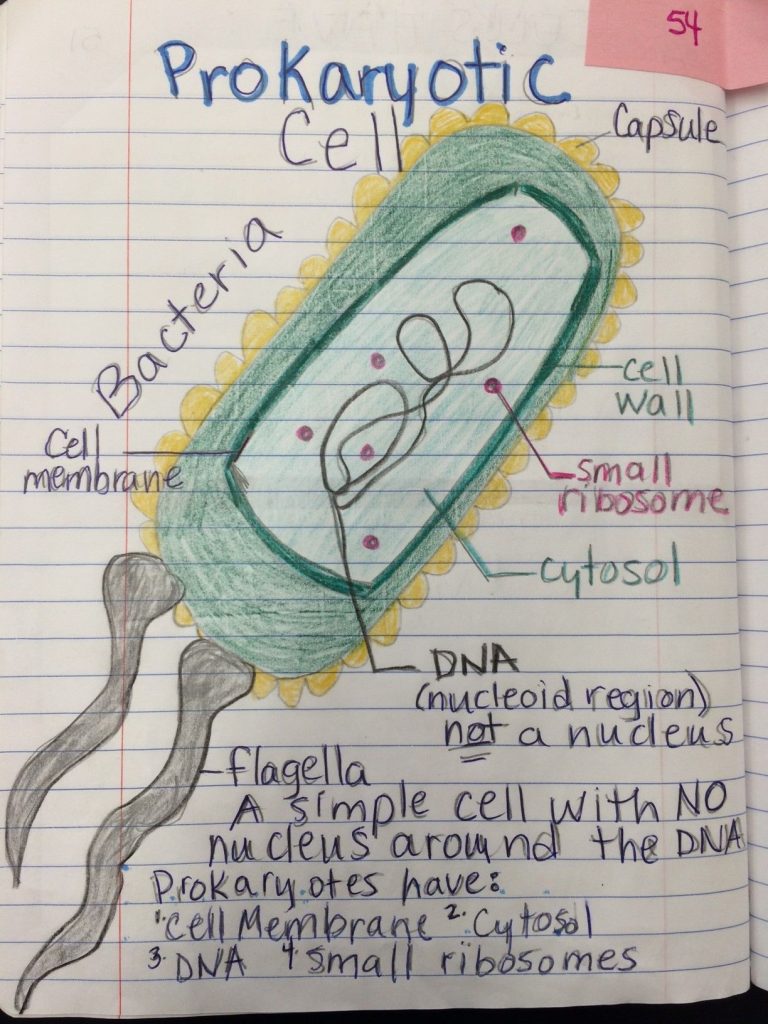Prokaryotic cells are found in bacteria, archaea and cynobacteria (blue-green algae). The cellular organization of prokaryotic cells is primitive as they lack a membrane-bound nucleus and other membrane-bound cell organelles.
Cell morphologies commonly found in prokaryotic cells are Coccus (pl. cocci) or round, Bacillus (plural : bacilli) or rod, Spirillum (plural spirilla) or spiral, Spirochete (plural spirochetes) or long, loose, helical spiral, etc. In addition to cellular shape, prokaryotic cells may group together in certain arrangements like Coccus (pl. cocci) or single coccus, Diplococcus (pl. diplococcic) or pair of two cocci, Tetrad (pl.tetrads) or grouping of four cells arranges in a square, Streptococcus (pl. streptococci) or chain of cocci, Staphylococcus (pl. staphylococci) or cluster of cocci, Bacillus (pl. bacilli) or single rod, Streptobacillus (pl. streptobacilli) or a chain of rods.
The structure of typical prokaryotic cells are described in more detail as:
Structures external to the cell wall:
- Glycocalyx: The glycocalyx ( capsule, slime layer, or extra cellular polysaccharide ) is a gelatinous polysaccharide and/or polypeptide covering lying externally to the cell wall. The exact chemical composition varies depending on the species. Capsules may protect pathogens from phagocytosis and enable adherence to surfaces, prevent desiccation, and may provide nutrients.
- Flagella: Flagella are long filamentous appendages consisting of a filament, hook, and basal body and help to push the cell by rotating. The filament is composed of the globular protein flagellin, which is arranged in several intertwined chains that form a helix around a hollow core. Motile bacteria move by taxis in two ways: Positive taxis or movement towards an attractant and negative taxis or movement away from a repellent.
- Axial filaments: Axial filament are similar to flagella, except that they wrap around the cell and spiral cells that move by means of an axial filament (endoflagellum) are called spirochetes.
- Fimbriae and Pili: Fimbriae and Pili are short, thin appendages. Fimbriae are usually many and help the cells adhere to surfaces while Pili are only one or two per cells and help join cells during conjugation for the transfer of DNA (sex pili) or are used for special types of movement like twitching in Pseudomonas aeurginosa, Neisseria gonorrhoeae and some strains of E.coli, or the gliding movement of myxobacteria.
- Cell wall: prokaryotic cell wall are composed of peptidoglycan in bacteria or pseudopeptidogycan in archaea. Cell wall in gram-positive bacteria are characterized by a thick peptidoglycan layer, whereas in gram-negative bacterial cells, the cell walls are characterized by a thin peptidoglycan layer surrounded by an outer membrane.
Structures internal to the cell wall:
- Plasma (cytoplasmic) membrane: The bacterial plasma membrane is a phospholipid bilayer with peripheral and integral proteins while the archaeal membranes are composed of fatty acids that are ether-linked to phospholipids. The plasma membrane of some prokaryotes contains infoldings called chromatophores that contain pigments involved in photosynthesis. The plasma membrane may also form irregular infolgings called mesosomes that functions either in DNA replication and cell division or excretion of exoenzymes. The plasma membrane across the membrane may be by passive processes like diffusion and osmosis or by active transport.
- Cytoplasm: Cytoplasm is the fluid component of the cell surrounded by the plasma membrane. The cytoplasm is composed mostly of water along with inorganic and organic molecules, DNA, ribosomes, and inclusions.
- The Nucleoid: Prokaryotic DNA and DNA-associated proteins are not bound by a complex nuclear membrane and occur as the nucleoid region in the cytoplasm of the cell. Prokaryotic chromosomes are typically circular and haploid (unpaired). In bacteria, Nucleoid-associated proteins (NAPs) interacts with prokaryotic DNA and function like histones of eukaryotic cells assisting in the organization and packaging of the chromosome. However, in archaea, either NAPs or histone-like DNA organizing proteins associate with the chromosomal DNA to organize the nucleoid.
- Plasmids: Prokaryotic cells may also contain small, circular, double-stranded extrachromosomal DNA molecules called plasmids. Plasmids are generally many in number per cell and often carry genes that confer advantages traits such as antibiotic resistance.
- Ribosomes: The cytoplasm of a prokaryotic cells contains numerous ribosomes of the type 70S. Ribosomes are made up of rRNA and proteins serve as the site for protein synthesis.
- Inclusions: Inclusions are reserve deposits found in the cells and some examples of prokaryotic cell inclusions found in bacteria are metachromatic granules (inorganic phosphate), polysaccharide granules (usually glycogen or starch), lipid inclusions, sulfur granules, carboxysomes (ribulose 1,5-diphosphate carboxylase), magnetosomes (Fe3O4 or magnetite), and gas vacuoles.
Endospores: Endospores are resting structures formed by some bacteria like Bacillus and Clostridium during unfavourable environmental conditions. The process of endospore formation is called sporulation and the endospore return to its vegetative state by a process called germination.
Sociability: although prokaryotes are unicellular, most of them can form stable aggregated communities in a polymer matrix called “biofilms”. Cells in biofilms often show distinct patterns of gene expression (phenotypic differentiation) in time and space. Bacterial biofilms are more resistant to antibiotics compared to the single bacterial cells and are difficult to remove from the surfaces of their colonization.
Social environment: Prokaryotes can inhabit nearly all environments. Some archaea and bacteria can even thrive in extreme conditions, such as high temperatures (thermophiles) or high salinity (halophiles) and such organisms are refused to as extremophiles. Some prokaryotes live in or on the bodies of other organism as symbiotic prokaryotes while many archaea grow as plankton in the oceans.
Reproduction: Bacteria and archaea reproduce through in an asexual mode of reproduction , known as Binary fission. During this, the genomic DNA undergoes replication followed by division site selection, invagination of the cell envelope and synthesis of new cell wall resulting in the division of the original cell into two identical cells.
Also have a look on the topic: Eukaryotic cells




















